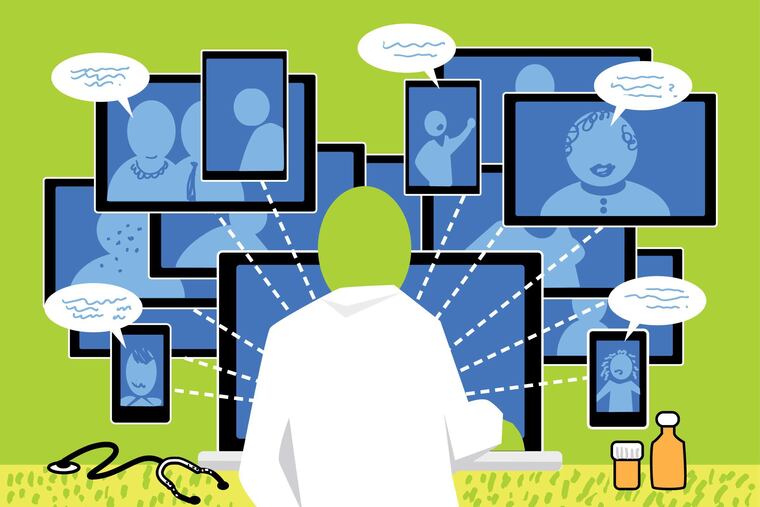Telemedicine doesn’t need to fade away after the pandemic | Expert Opinion
The coronavirus moved us toward a model of health care that works for many people. We shouldn’t go backward.

This past year, telemedicine has been a critical alternative to in-person visits. They’ve helped doctors like me stay connected to patients, a lifeline for some. Many patients, particularly those with mental health struggles, have told me how much easier it is to see me from home, avoiding the hassle of traveling to “see me” in person. Other doctors — psychiatrists, sleep specialists, neurologists, and dermatologists –—have told me similar stories and use telemedicine to manage many conditions remotely, providing needed access for many and sorting out who should be seen in person.
However, it’s at risk of fading away. Telemedicine visits have dropped off since the initial peak early in the pandemic. This was expected. Some diseases need in-person evaluations and some patients prefer in-person visits. But now, many doctors have scaled back further, in some cases advocating for in-person visits first.
» READ MORE: Coronavirus has forced doctors, insurers to embrace telemedicine like never before
The reason is a classic one for health care — doctors worry telemedicine may not be worth the trouble if insurance companies pay less than in-person visits. Some doctors worry insurers won’t pay for it at all. Currently, pandemic-related federal and state public health emergency declarations have supported telemedicine’s expansion by requiring doctors be paid equally for telemedicine and in-person visits. However, as the pandemic feels that it’s nearing its end, the looming end of telemedicine’s pandemic reimbursement rates weighs heavily on doctors and their business offices, so many are preparing by scaling back now instead of waiting.
Telemedicine’s fate, at this point, feels in the hands of insurers. Yet, Medicare, often a standard-bearer for new payment models, hasn’t come out with declarative statements, and commercial insurance companies have largely remained quiet about how they will proceed. The uncertainty is a sign of skepticism, damaging telemedicine’s future.
There are good reasons for insurers to be skeptical. If telemedicine becomes so easy that every minor ailment results in a telemedicine visit, when a person wouldn’t have sought care to begin with, that’s likely not a good thing — driving up the costs of care unnecessarily. For doctors who see a mix of telemedicine and in-person visits, these visits crowd out appointments for people with more pressing needs.
However, to counterbalance, the improvements in access to care made through telemedicine should not be ignored. Between April 2020 to February, Penn Medicine OnDemand — our virtual urgent care service — saw over 6,000 patients who did not have a primary care doctor, and nearly 600 patients established one after their virtual visit.
Overall primary care visit completion rates at Penn Medicine have also reached records for poor and Black patients who traditionally face significant barriers to care. While those patients may be less likely to use telemedicine or afford cellular data or internet plans, the telemedicine used — video and phone — is likely overcoming challenges in-person-only models of care create. These data indicate telemedicine’s potential should be maximized, not having its availability reduced.
How can the general public guide telemedicine’s fate?
First, use and advocate for telemedicine from your doctor when you think it meets your needs. Like in other aspects of our life, we can’t imagine a world now without modern conveniences: mobile banking, online shopping, or smartphones. The integration of these advances into our personal lives occurred because companies responded to the demands and adapted to the needs of customers. Patients are our customers, and health care should find a way to provide better, more accessible care when you want it.
Second, you are not powerless. Legislators and insurers do listen. You (we) are their customers after all. If telemedicine has improved your ability to access your doctor, and you advocate for using telemedicine with your representative or from insurers, the risk of telemedicine fading away is lowered. Payment policies that generate more favorable payments to doctors’ offices will lower pressures to reel telemedicine back. Instead, we’ll push forward, learning when it is best to see you in person or using telemedicine.
As this pandemic hopefully comes to a close, we have an opportunity to benefit from the gains made during a tumultuous period in our personal lives and nation’s history. Telemedicine has moved us toward a health-care system that provides care when people need it, and where they want it. Let’s not let it quietly fade.
Krisda H. Chaiyachati is medical director of Penn Medicine OnDemand Virtual Care, a senior fellow at the Leonard Davis Institute of Health Economics, and an assistant professor of medicine in the Perelman School of Medicine.